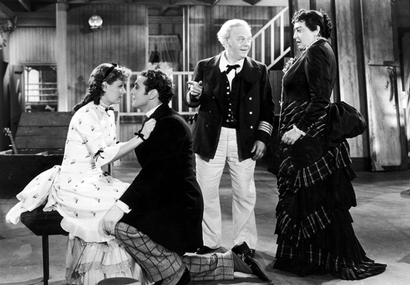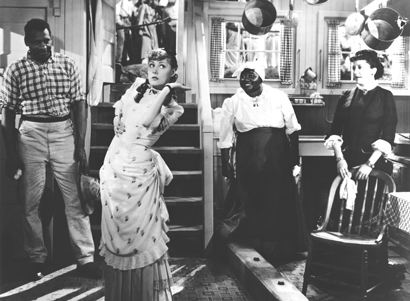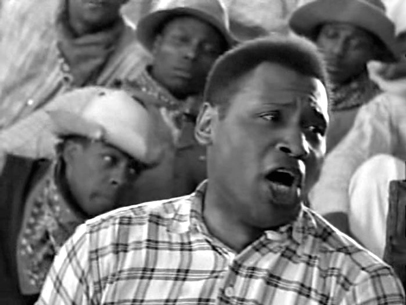
 |
|
|
|
Credited as the Broadway musical that shifted the form away from frivolous comedies to dramatic plays, Show Boat was based on Edna Ferber's popular multi-generational novel about the fortunes of a river-going entertainment troupe. It was almost immediately filmed was well, by Universal as a part-talkie in 1929 film, and again in a much more lavish 1936 version with Irene Dunne. The reason that both have faded from the collective memory is that they disappeared for the better part of forty years. The Irene Dunne Show Boat wasn't shown on television until the 1980s. Some fans thought that the its racial content had made it unacceptable for TV, and others may have concluded that the show's suppression had something to do with the blacklisting of its star Paul Robeson. But the truth is a straight business story: in 1951 MGM released a glossy but simplified Technicolor production with Kathryn Grayson, Howard Keel and Ava Gardner. When MGM bought up the film rights it also took possession of the old versions... and quietly locked them away. 1 
The 1936 version is now widely acknowledged as the best, a class act from stem to stern. The warm-hearted classic features unforgettable songs and performances. Show Boat's director James Whale cast the film largely with stars from the original New York production and most of the others had played in road companies or abroad. Irene Dunne's stage performance had won her an RKO contract, and she's simply marvelous. This is the only American musical to feature the enormous talent Paul Robeson. His song Ol' Man River is so powerful that audiences frequently assume it to be an authentic folk spiritual. Whale's sophisticated direction raises the drama far above Nelson Eddy-Jeanette MacDonald operettas of the time. Fans of the later big-screen Rodgers & Hammerstein Broadway adaptations of the 1950s will be impressed: minus color and widescreen, this musical is as good if not better than most of them. Warners has long promised a deluxe edition of Show Boat but in the meantime is releasing its latest restoration through its Warner Archive Collection label. It is highly recommended. The screenplay drops some of the songs, but keeps most of the original storyline intact. Capn' Andy (Charles Winninger) commands the beloved show boat Cotton Palace, performing up and down the river. His wife Parthy Ann (Helen Westley) makes it her mission to keep their daughter Magnolia (Irene Dunne) separate from the 'undignified' actors in Andy's troupe. Elly May and Frank (Queenie Smith & Sammy White) sing and dance and do comedy, while the company's star is the beautiful Miss Julie LaVerne (Helen Morgan). But when Julie is revealed to be a black passing for white, she and her husband Steve (Donald Cook) run afoul of miscegenation laws and must leave the show. Magnolia takes her place, and Andy hires the gambler Gaylord Ravenal (Allan Jones) to play opposite her. Against Parthy Ann's dictates, the new pair falls deeply in love... 
Show Boat benefits greatly from James Whale's careful attention; with his extensive stage experience the director opens up the play but does not lose the focus on its rich characters -- or water down its racial politics. Miss Julie is denounced as passing for white, a prison offense. Her husband Steve finds a proud way to sidestep the letter of the law, but Miss Julie has no choice but to leave the show forever. The sense of injustice communicated by this scene makes Show Boat seem racially progressive, despite the fact that a large group of 'darkie' laborers are always in the background. Also erasing most objections are Hattie McDaniel as the boat's cook Queenie, and her 'man' Joe, played by Paul Robeson. As a character Joe verges on a shiftless stereotype, yet he serves as the play's racial conscience. As the Ol' Man River song explains the misery of work for blacks along the river, the montage cutting behind the song cuts to an array of arresting expressionist images. A 1926 play about the 1880s South is not going to be a fountain of PC platitudes. Despite the sympathy given racial issues, it can't be denied that Show Boat reveres the un-reconstructed South of the late 1800's as the 'Good Old Days'. Universal did add one unfortunate blackface number, performed by Magnolia after her own career is established. Ironically, the film's most lyrical and inspired scene also invokes racial differences, but in a harmless way. Joe and Julie join Queenie in her kitchen to sing Can't Help Lovin' Dat Man. Queenie asks Julie: "How come you know that old song?" The capper comes when young Magnolia does an impromptu dance, imitating a shuffling black. It's affectionate, adorable and hilarious, without apologies. What attitude is correct, when charismatic black performers playing demeaning roles conceived by whites, transcend the context and promote positive racial attitudes? 
Irene Dunne and Allan Jones' love duets range from genuinely touching (Make Believe) to merely cute (the number they sing from the windows of their show boat cabins). Charles Winninger propels his own brand of sentimentality and is singlehandedly responsible for at least two more show-stopping moments. When one of his primitive plays breaks down on stage, Winninger's Cap'n Andy leaps up and narrates/performs an entire fight scene with such enthusiasm that he wins applause from the audience. In her big New Year's Eve singing premiere, the discouraged Julie is bombing on stage. Her father suddenly appears in the audience, and rallies the crowd to follow her in singing the old standard After the Ball (is Over). All of the musical moments I've described are profoundly sentimental, judged and timed to bolster the story's more melodramatic turns. Men leave their women, women go back to performing, women sacrifice for each other. The legendary Helen Morgan was the original Julie LaVerne in Florenz Ziegfeld's stage show. She made a number of pictures including Rouben Mamoulian's nearly experimental talkie Applause, and also played Julie in a prologue for the 1929 version. But this Show Boat was her last film and her most accessible. The quintessential torch singer by the piano, Ms. Morgan was to die of alcoholism at an early age. Show Boat has impressive production values: giant sets and large crowd scenes. The showboat is a beauty and several streets appear to have been constructed to represent a riverside town. John Fulton's fancy matte shots frequently place the boat against river backgrounds, especially at night. And the orchestrations and sound recording are particularly good ... many of the stage songs dropped for the movie are heard as underscore, transition themes and under the main titles. Besides the blackface number, the film's only (debatable) stumble is the ending, which effects a romantic reconciliation in the big city instead of back on the showboat. We witness a grand stage performance by Magnolia's daughter, now grown. As this is now 1925, we assume that the Cotton Palace is no more. Unlike the play, we also never see Queenie or Joe again; they in fact disappear from the movie about halfway through. But it's difficult to quarrel with a show that yields such emotional riches. 
The Warner Archive Collection DVD-R of Show Boat is the clearest, sharpest version of this great show yet released. The restoration work has cleaned up damage and I'm pretty sure that some bad scratches from earlier releases are now gone. If the picture seems a tad soft it's surely the film stock and shooting style of 1936. The audio track is particularly good, and presents Robeson's deep, deep voice free of distortion. We're all hoping that the movie will resurface in Blu-ray in few years along with the 1929 part-talkie version (which I have not seen). No extras are included; it's possible that no trailers exist because they weren't preserved when MGM took possession. A garish original poster is used for the disc package art. Other styles featured Paul Robeson prominently, but he doesn't appear on this one. |
|||||||||||||||||||
Review Staff | About DVD Talk | Newsletter Subscribe | Join DVD Talk Forum
Copyright © MH Sub I, LLC dba Internet Brands. | Privacy Policy
Subscribe to DVDTalk's Newsletters
|